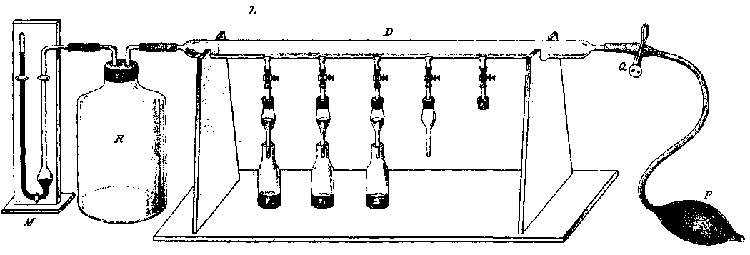Mikhail Tswett (1906) "Physikalisch-Chemische Studien über das Chlorophyll. Die Adsorption." (Physical-chemical studies of chlorophyll. Adsorption.) Berichte der Deutschen botanischen Gesellschaft, vol. 24, pp. 316–326. On page 322, Tsvet coins the term "chromatography":
Original : "Wird eine petrolätherishe Chlorophyllösung durch eine Säule eines Adsorptionsmittels durchfiltriert (ich verwende hauptsächlich Calciumcarbonate, welches in engen Glasröhren dicht gestampft wird), so werden die Farbstoffe gemäss der Adsorptionsreihe von oben nach unten in verschieden gefärbten Zonen auseinandergelegt, indem die stärker adsorbierten Farbstoffe die schwächer zurückgehaltenen weiter nach unten verdrängen. Diese Trennung wird praktisch vollständig, wenn man nach dem Durchgange der Farbstofflösung durch die adsorbierende Säule einen Strom des reinen Lösungsmittels herstellt. Wie die Lichtstrahlen im Spektrum, so werden in der Calciumkarbonatsäule die verschiedenen Komponenten eines Farbstoffgemisches gesetzmässig auseindergelegt, und lassen sich darin qualitativ und auch quantitativ bestimmen. Ein solches Präparat nenne ich ein Chromatogramm und die entsprechende Methode, die chromatographische Methode."
Translation : If a solution of chlorophyll in petroleum ether is filtered through a column of an adsorbent (I use mainly calcium carbonate, which is tamped firmly in narrow glass tubes), then the pigments are dispersed, according to the adsorption series, from top to bottom in differently colored zones, by the more strongly adsorbed pigments' displacing farther downwards the more weakly retained ones. This separation is practically complete when one establishes a flow of pure solvent behind the passage of the pigment solution through the adsorbing column. Like light rays in a spectrum, so the different components of a mixture of pigments are dispersed in the calcium carbonate column following a set pattern, and [they] can be determined in there qualitatively as well as quantitatively. I call such a preparation a "chromatogram" and the corresponding method, the "chromatographic method".
I believed he used an extraction of green leaves with chloroform as his sample. I would dry the sample and redissolve into petroleum ether (hexanes).
You can find hexanes, chloroform, chlorophyll species, and calcium carbonate from a company like Sigma Chemical, St. Louis, MO. Gasoline is a possible substitute for hexanes, but not recommended as it may contain aromatics and it usually is dyed to add color.
best wishes,
Rod

